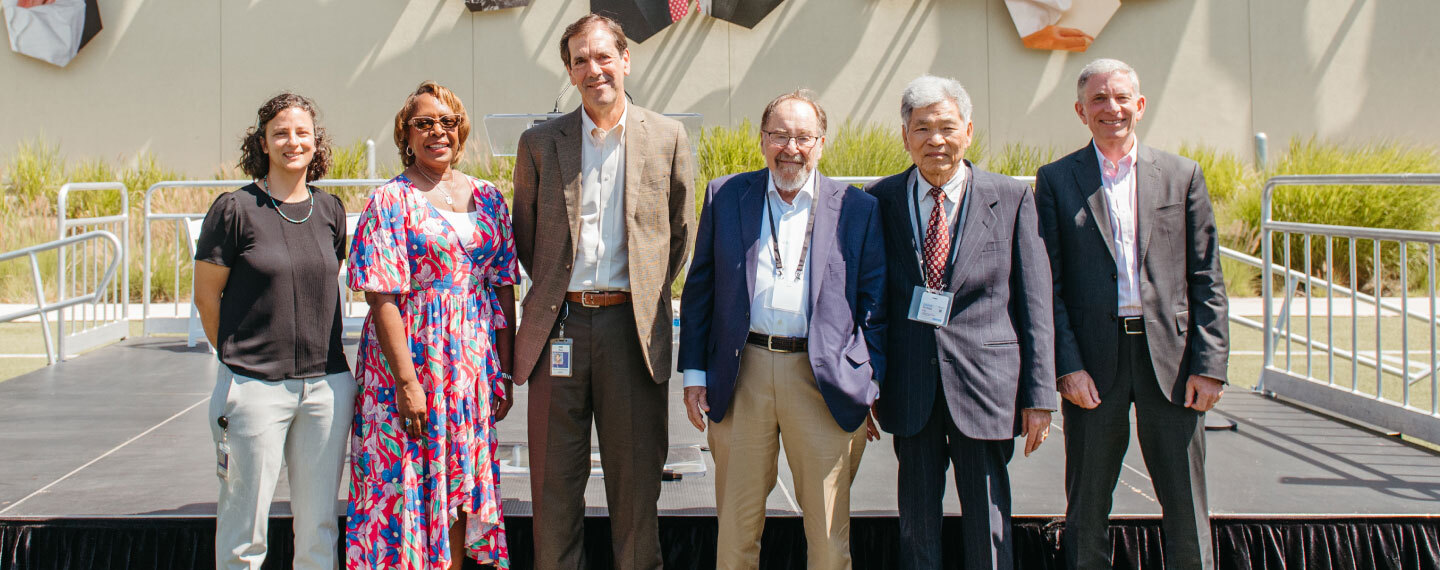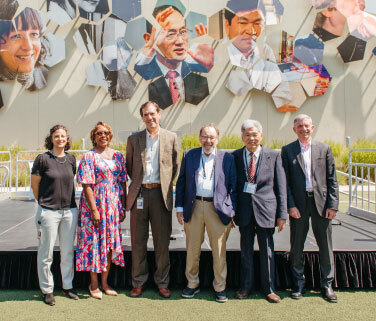For over 40 years, Amgen has lived and breathed biotechnology. To honor this deep history, a team of Research & Development (R&D) staff members has developed a new mural to highlight a diverse group of impressive scientific figures who have made outstanding contributions to drug discovery and development.
The goal of the mural is to recognize scientists from all backgrounds and promote a sense of belonging and inspiration among all Amgen staff.
"Because of inequity in historical opportunity, we have tended to honor people who already benefit from relative privilege. It is so normalized that we do not notice its prevalence in almost every space," said Sarah Van Driesche, senior scientist in R&D at a June 21st ceremony to present the mural. "I imagined what it might mean to create a new scientist wall here at Amgen, one that more fully represents and reflects our community," added Van Driesche, who initiated the mural effort.
She brought the idea to her manager and other R&D colleagues and received overwhelming support at all levels. The team carefully deliberated on candidates, encouraging staff to think outside the traditional box to include a broader range of candidates than only Nobel Prize recipients. They then voted for their favorites, who now appear on the mural that was recently installed on a wall at the heart of the R&D buildings at Amgen's headquarters in Thousand Oaks, California.
Recognizing longtime Amgen friends
Retired Amgen researcher, Fu-Kuen Lin and Scientific Advisory Board co-chair and a previous long-time member of the Amgen Board of Directors, David Baltimore were on-site for the ceremony. Both are featured on the mural.
"I am very honored and humbled to be on this mural with these inspiring and life-changing scientists," said Lin, whose research helped pave the way for Amgen's first medicine. "In 1981 I joined Amgen as a scientist and was fortunate to have the opportunity to tackle the erythropoietin project and had the support of the whole company."
"It is wonderful to be back at Amgen," said Baltimore. "Having spent 20 years on the board, I feel a part of the history of this great company."
"Reverse transcriptase was one of the first tools of biotechnology and opened one of the great new commercial opportunities of our time," he added about his seminal discovery, "with Amgen in a lead position."
Learn more about these scientists and their contributions to biotechnology below.

From left to right: Rosalind Franklin, David Baltimore, Frances Arnold, David Klenerman, Shankar Balasubramanian, Jennifer Doudna, Emmanuelle Charpentier, Jane Cook Wright, Shinya Yamanaka, Fu-Kuen Lin, Mary-Claire King, Georges Köhler and César Milstein.
Frances Arnold received the 2018 Nobel Prize in Chemistry for pioneering the use of directed evolution in enzyme engineering, an important technique that is used in protein drug design.
Shankar Balasubramanian & David Klenerman received the 2020 Millennium Technology Prize for inventing high throughput next generation DNA sequencing. DNA sequencing is important in understanding the biology of disease, identifying drug targets and selecting patients who can benefit most from a medicine.
David Baltimore discovered the enzyme reverse transcriptase, for which he was awarded the 1975 Nobel Prize in Physiology or Medicine, together with Renato Dulbecco and Howard Temin. Reverse transcriptase has been a critical enzyme necessary to understand gene activity in disease and to find genes of interest for drug discovery and development.
Jennifer Doudna & Emmanuelle Charpentier received the 2020 Nobel Prize in Chemistry for the discovery of CRISPR, a molecular technology that allows programmable and precise genome editing. Genome editing is important when researching the basic biology of a disease and in the development of human gene therapy.
Rosalind Franklin was a groundbreaking chemist whose X-ray diffraction studies provided the empirical data for the structure of DNA that enabled development of the Watson-Crick model. Understanding the structure and function of DNA has been seminal in studying the biology of disease and in using biotechnology to develop precision medicines that are based on an individual's genetic makeup.
Mary-Claire King was awarded the 2014 National Medal of Science for pioneering contributions to human genetics, including discovery of the BRCA1 susceptibility gene for breast cancer and the development of genetic methods to match "disappeared" victims of human rights abuses with their families. Genetic markers like BRCA1 are important for disease research, diagnosis and precision drug development.
Georges Köhler & César Milstein developed hybridoma technology for the generation of monoclonal antibodies, a critical method in the development of biologic therapeutics and diagnostics. For this work they received the 1984 Nobel Prize in Physiology or Medicine, shared with Niels Jerne.
Fu-Kuen Lin identified and cloned the erythropoietin gene from among 1.5 million fragments of the human genome in 1983, a herculean task given existing technology at the time. The discovery enabled the creation of one of the most successful drugs in biotech history and was the foundation for Amgen's success.
Jane Cooke Wright pioneered groundbreaking chemotherapeutic approaches for treatment of cancer in the 1950s, facing steep resistance at a time when surgery was the primary treatment modality and anti-cancer drugs were considered experimental therapies. Chemotherapy remains an important way to treat cancer and is often used in combination with biologic medicines.
Shinya Yamanaka received the 2012 Nobel Prize in Physiology or Medicine together with Sir John B. Gurdon, for the discovery that mature cells can be reprogrammed to become pluripotent stem cells. These induced pluripotent cells have become an important tool for modelling and investigating human diseases, as well as for screening drugs.





